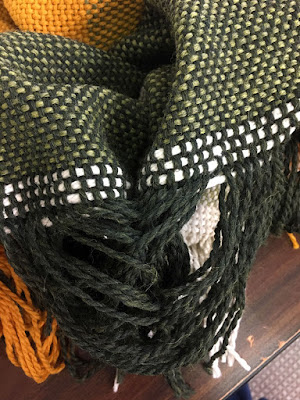After weaving to the very end of my warp, I got to start cutting off the loom and knotting the warp to anchor the ends of the cloth.
 |
| Those knots are really satisfying to tie. |
Bit by careful bit, and standing on the treadles that raise the upper layer of cloth, to be certain I didn't tie warp ends from both layers together. After all the fussing in the weaving process to be sure and
not attach the layers to each other, it would be very sad to make the whole production into a large woolly taco at the end.
 |
| FLOP. |
With the whole top layer cut off, I got to work back across the loom, tying the warp ends from the lower layer and wrangling the top layer both out of my way and onto the breast beam to keep it from tugging at the remaining warp.
 |
| BIGGER FLUMP. |
And then I got to unroll my blanket from the cloth beam! (And see all the floats on the underside of the lower layer of fabric for the first time...yikes.) Since I'd tied half-bows on the front apron rod, I managed to keep the entire length of the warp at the starting end of the cloth—all I had to do the release that end was tug the tails of the half-bows and pull the fabric free.
 |
| Ends everywhere, but it's so pretty! and I made it! |
To completely unfold the fabric, I needed to untangle the fringe that had been tied to the front apron rod, where it hadn't been separated into upper and lower layers, and pull out the scrap rows of mop cotton before knotting the fringe to secure the edge.
 |
| Fringe completely uninterested in letting go so I could unfold the fabric. |
I may have mentioned this yarn, while lovely, is somewhat prone to felting if you look at it funny? The fringe wasn't precisely
felted, but it also wasn't just sliding apart. When I'd untangled the doubled fringe, I got to carefully pick free the four starter rows of mop cotton. I could have cut the scrap yarn and picked the pieces out more quickly, but waste makes me twitchy, and I'm certain I'll have a use for sturdy cotton yarn again someday.
Besides, I was listening to the shop's founder tell the story of how she got into the business, and that was worth taking time to listen to.
 |
| It's like bunting! |
I knotted the fringe on the short end of the blanket as I had while cutting it off the loom, and fixed a few of my floats and weaving errors before packing up to go home, about midday on the third day of the workshop.
Don't worry, though, there are two more posts on the finishing of the blanket, and lots more photos.






Comments
Post a Comment